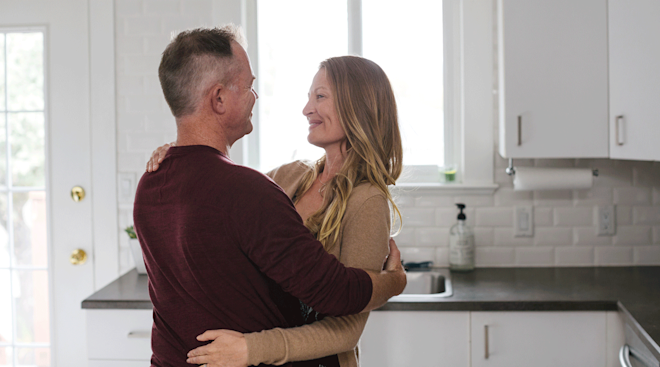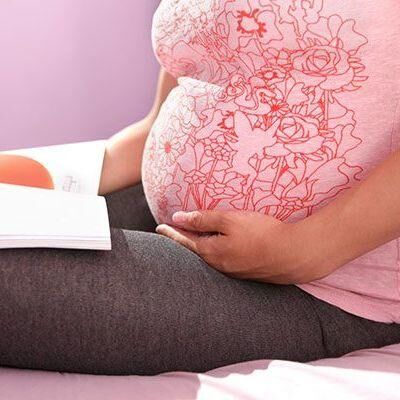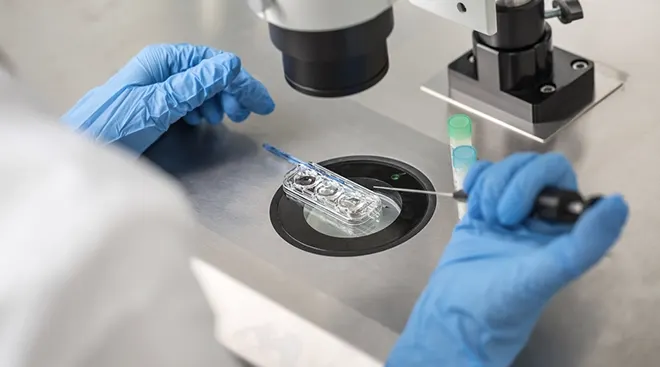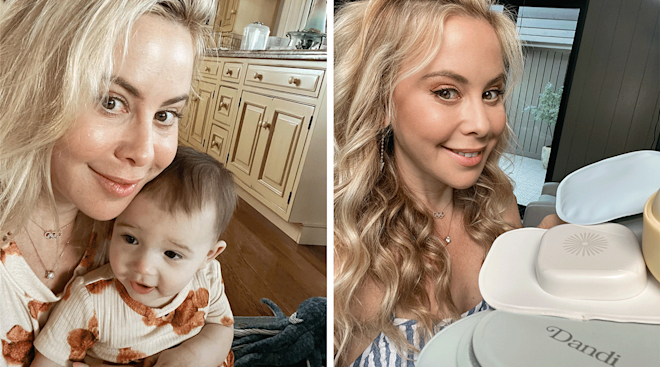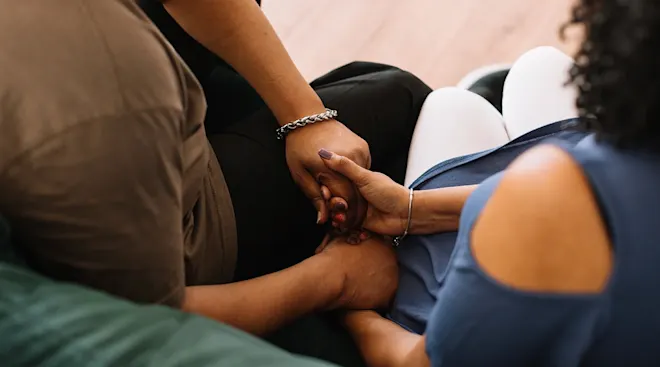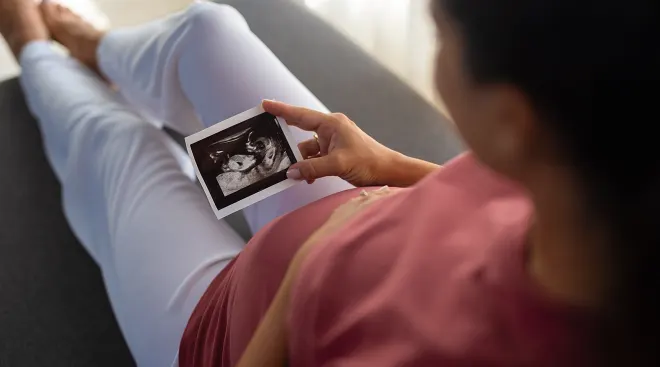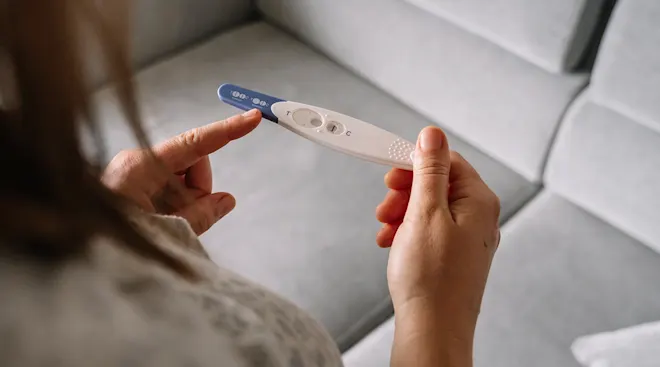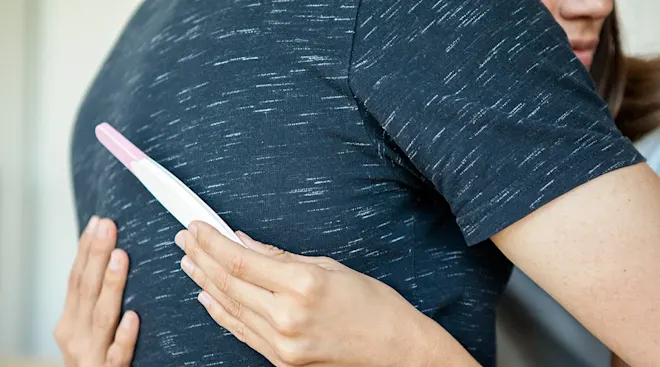Months of Struggles, Then Two Pink Lines: My Battle for a Second Baby
Every time the bleeding would start, I was certain my pregnancy was over. Feeling hollow and out of control, I’d pull myself into a tiny ball on the floor, rocking back and forth, grieving the loss of the little person I was convinced I’d never know. And each time my guilt would swallow me whole. “After all, this was my fault,” I thought. “I did this to my baby—to us.”
My husband and I had been trying for a second child for months. Our daughter was one of those “first try” miracles that seemingly never happen in real life; a phenomenon reserved solely for one-night stand Rom Coms. I had told myself that it’d probably take a while the second time around, but logic didn’t do much to lessen the blow when I would start taking pregnancy tests, praying for one to be positive. It was a tedious cycle that we endured for the better part of a year, before finally deciding to talk to my OB. I hated having to admit that we couldn’t do this on our own, as if it somehow devalued my role as a woman (idiotic, I know).
Much to my relief, she seemed optimistic in our ability to conceive, but, to be safe, recommended we do some tests and start follicle scanning to boost our chances of conceiving. (For the record, follicle scanning is just a fancy way of saying “getting probed with a plastic wand to track ovulation.”) But my relief was short-lived. After completing the scanning, I began compulsively taking early response tests a few days before my expected period. Negative. Negative. Negative. One after the other.
Then, as if on cue, my doctor’s office called; our labs had come back, and she was no longer as confident as she once was. It was time, my doctor said, to consider seeing a specialist. A “natural” pregnancy (I hate that term) might not be possible for us. I had accepted that getting pregnant the second time wouldn’t be easy, but I never considered that it wouldn’t actually happen.
My period started the very next day.
“At least we know,” my husband had said. “We know now and can start moving forward.”
I knew he was right, and I appreciated how dedicated he was to remaining upbeat. But I was scared. Seeking the help of a fertility doctor would mean more appointments, more poking and prodding, more needles, more hopes, more disappointments and so much more money. I was tired and discouraged, but what choice did I have?
We found a specialist through the recommendation of a friend. He had a glowing reputation, but wasn’t known for an overly friendly bedside manner—which I discovered for myself as he began his introductory spiel. To hear him say it, at the ripe age of 35, I was old as sh*t. Medically speaking, I had cobwebs in my uterus.
According to him, a 35-year-old woman has two to three chances a year, on average, to get pregnant. That’s it. If a woman is releasing a single egg every cycle, only one out of every five eggs produced is viable. In other words, you might release a totally bunk egg for four months before finally releasing an egg that can actually be a baby.
He suggested we consider an IUI—a procedure where they pump me full of Clomid so I release multiple eggs, and then track my ovulation before turkey-basting me with some carefully selected sperm. Sexy, right? He said he didn’t want us wasting another six months trying on our own (after which, I’d be 36 and basically on death’s door) and further decrease our chances.
First though, he wanted me to have an HSG—an X-ray procedure where a doctor shoots fluid through your uterus and fallopian tubes to detect any abnormalities. After all, there was no point in doing the IUI if my plumbing wasn’t working. I agreed and scheduled the HSG for a few days later.
The day rolled around, and as I filled out paperwork, the nurse asked me if I was sure I wasn’t pregnant.
“No I’m not,” I said. “That’s sort of why I’m here.”
I asked her if we should hold off on trying this month, because of the procedure.
“Oh no, go for it,” she said. “The HSG is like roto rooter: cleans everything out. Lots of couple get pregnant right after!”
The procedure took about 15 minutes, after which the doctor informed me that everything looked normal. “But did your doctor say anything about this mass during your last ultrasound?” he asked.
“No,” I said.
“Hmmm,” he started. “Well, it’s probably just a little cyst, but it’s preventing your uterus from completely filling up. I’ll let his office know.”
I’d had cysts before, so this wasn’t out of the ordinary; I figured if it was anything major, my doctor would call me. My husband and I carried on that month per usual, and felt a little bit calmer about it all. One way or the other, I felt hopeful we were on the road to having a baby.
And just like that, three weeks later, I saw it: A bright pink POSITIVE line. There was no mistaking it—we were pregnant! I called our fertility doctor and his office suggested I come in for a blood test to confirm.
“Congratulations, you’re definitely pregnant,” the nurse said when she called with the results. “But we need you to come back over. Your progesterone is low and we need to give you some medication. When was the date of your last cycle?”
I told her it was nearly four weeks earlier.
“Hmmm,” she said. “Are you sure?”
“Positive,” I said. “I’ve been tracking it for months.”
Apparently, my hormone levels were through the roof, which either meant I was further along than usual, or I was having twins. I ditched my afternoon IKEA plans and headed back in for an ultrasound.
“You’re definitely pregnant,” the doctor said. “Just one baby, measuring about seven weeks.”
“Seven weeks!” I said. “But I had a period!” “It happens,” he said.
“The pregnancy tests were all negative.”
“It happens,” he said.
“Oh sh*t,” I said, remembering my trip to the Veuve Cliquot Polo Match a few days earlier. “I drank so much champagne!”
“Leslie, that’s all fine,” he said. “Actually, I’m most concerned about the HSG procedure.” I hadn’t even considered the HSG. The anxiety started rushing in; that “mass” they had discovered wasn’t a cyst—it was my baby. I started bracing for the worst.
“What are the risks?” I asked, now terrified that I had exposed my child to radiation. “If anything, the HSG would have just terminated the pregnancy, but I think you would have miscarried by now,” he said. “Still, we’ll monitor it.”
Ten days later, without warning, I started bleeding. It wasn’t the brown spotting that pregnancy blogs warn you about; this was a bright, red flood. I screamed for my husband, who was putting our daughter to sleep, and he found me in the bathroom, my face white with terror.
“This is it,” I sobbed, my head in my hands as my husband rubbed my back. “I’m losing the baby.”
“You don’t know that,” he said, trying his best to be calm.
“No, it’s over, it’s over,” I kept repeating, refusing to be filled with false hope.
He called the doctor’s after-hours line, and the nurse told us to come in the following morning. I fell asleep that night out of sheer exhaustion as my husband held me tight.
At 6:45 a.m., we were back at the doctor’s office. I held my breath as the tech began searching for the baby. Without saying a word, she turned up the volume—and there it was: a healthy heartbeat. I collapsed into the ugliest, most aggressive sob, the kind where I had to be told to breathe so I wouldn’t hyperventilate. “What was all the blood from, then?” I wondered.
It could’ve been from the progesterone suppositories, the doctor suggested. I was told to expect a bit more blood and to stay off my feet as much as possible. The bleeding continued lightly off and on for the next few days and then tapered off.
But 15 days later, the bleeding started again. It was heavier; more aggressive and more ominous. I panicked. I didn’t want to tell my husband. I didn’t want it to be real. I was losing my baby this time, I just knew it—and it was all my fault. After the first incident, I began reading up on HSGs and learned that most offices make you take a pregnancy test beforehand. The only data I could find stated that more than half of all pregnancies terminated after the procedure. My husband found me naked and hysterical on the bathroom floor. I was soaking maxi pads with blood; it was the telltale sign that a miscarriage was inevitable.
The next morning, I drove to the doctor’s office, readying myself for the bad news. Just as he did last time, the doctor looked for the baby—and there was a perfect heartbeat. This time, the doctor spent a bit more time looking around for the culprit of this bleeding, but couldn’t find anything abnormal. My strong little baby had survived yet again, but I couldn’t feel quite as relieved. “There was so much blood,” I said. “It doesn’t make sense.”
He told me not to overanalyze it, put me on pelvic rest and suggested I make an appointment with my OB now that I was inching closer to the 12-week mark and would soon “graduate” from infertility school. I was grateful, but I knew something was wrong. I stopped talking baby names with my husband, stopped Pinterest boarding nurseries, stopped planning for the baby all together.
Six days later, the bleeding began again. Coincidentally, I had an appointment with my OB that afternoon. I sat in the waiting room for over an hour, surrounded by women with beautiful round bellies as I continued to bleed. My husband kept asking the receptionist how much longer, but it wasn’t until my sobs started to attract the attention of other patients that a nurse ushered me into an ultrasound room.
Up until then, all of my ultrasounds had been vaginal, but the tech said I was far enough along for an abdominal ultrasound. It took her about 15 seconds to find the sub chorionic hematoma (SCH)—basically a giant blood bruise—that was resting alongside my baby. Before that moment, I’d never heard of SCHs. I learned mine was on the larger side, and bigger wasn’t better. If the SCH continued to grow, it could cause preterm labor and basically push the baby out.
My husband and I didn’t know what to say. On one hand, we were relieved that there was an actual source of the bleeding, but now we were terrified for all new reasons.
“Could this have been caused by the HSG?” I asked.
She shrugged. “There’s really no way of knowing.”
Not only was I to stay off my feet, I was put on total bed rest. I couldn’t even sit at my desk or dinner table. The hope was that with minimal activity, the SCH would start to shrink and ultimately bleed out or reabsorb. Other than that, there wasn’t much to be done. It was sort of a “sit and wait” game.
My husband I stared at the ultrasound monitor of our baby and the big black monster floating next to it.
“Do you know the sex?” asked the ultrasound tech.
“Not yet,” I said.
“Do you want to know?” she asked.
My husband and I looked at each other, and nodded.
“Congratulations, you have a very brave little boy on your hands.”
I sobbed. It was one of those things that you’re not supposed to admit, but I desperately wanted a boy—and there he was on the screen in front of me. I wasn’t sure if I’d ever get to hold him or kiss him, but he was mine.
For two weeks, the ultrasounds showed minimal reductions in the size of the SCH, but nothing significant. I was frustrated and scared, and going crazy after 21 days of sitting in bed with nothing but Channing Tatum movies to keep me company. The good news was that my baby boy was getting bigger, and the stronger he was, the better of chances, and while I continued to bleed, it wasn’t the flood that had terrorized me before.
Six weeks after it all began, I finally passed that f*cking hematoma. It wasn’t scary; in fact, it was cathartic. Small remnants of the bleed remained, and over the next few weeks of ultrasounds we saw the rest of it disappear. To hear the ultrasound tech tell it, “I was safely out of the danger zone.”
I’ve wondered a lot about what I could have done differently during this ordeal. Would I have avoided it all together had I never done the HSG? Or was that first phantom period already a symptom of the SCH˜? Was getting the HSG, which caused me to be monitored so closely, a blessing in disguise? Did the progesterone save me from miscarrying? Or were the suppositories somehow the catalyst for all the bleeding? I still have no idea.
I’m now 20 weeks along, and my baby is developing beautifully. While I’m still a bit emotionally fragile, I’m also eternally grateful. Instead of hating myself for what I thought I put my baby through, I’ve developed a great sense of appreciation for my body. I know my story doesn’t hold a candle to the countless women who’ve suffered tragic loss, sometimes time after time. It doesn’t compare to the mourning of birthdays never reached and names never given. I also know that many women don’t share their struggles with trying to conceive. I understand why; it’s deeply personal. But when I was stuck in bed, wide awake at 3 a.m., I was searching for someone who had been down this road before and could offer me a little hope and support. So that’s my story.
Every time the bleeding would start, I was certain my pregnancy was over. But now I know, it was only his beautiful beginning.
Published January 2018
Leslie Bruce is a #1 New York Times bestselling author and an award-winning entertainment journalist. She launched her parenting platform Unpacified as a place for like-minded women to come together on relatable ground, no matter how shaky, to discuss motherhood through an unfiltered, judgment-free lens of honesty and humor. Her motto is: ‘Being a mom is everything, but it’s not all there is.’ Leslie lives in Laguna Beach, California with her husband, Yashaar, their 3-year-old daughter, Tallulah, and looks forward to welcoming a baby boy this spring.
Please note: The Bump and the materials and information it contains are not intended to, and do not constitute, medical or other health advice or diagnosis and should not be used as such. You should always consult with a qualified physician or health professional about your specific circumstances.
Navigate forward to interact with the calendar and select a date. Press the question mark key to get the keyboard shortcuts for changing dates.


































